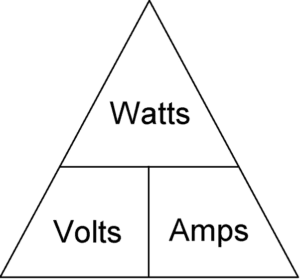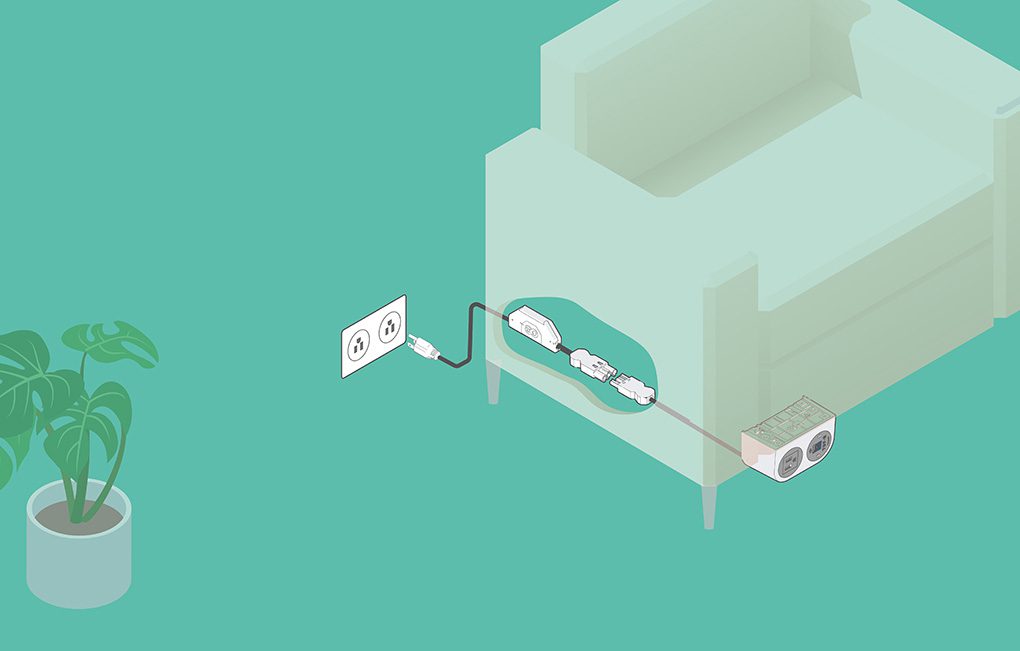They’re all just different metrics to measure the power of an electric circuit. That’s all you really need to know. 
Just make sure you always compare the same metric so it’s apples to apples. If you want to power a laptop that requires 60 watts of power, don’t accidentally specify an outlet requiring 60 amps. Amps and volts and watts are kinda related but not really (told you, it’s complicated.)
As long as you always compare amps to amps, volts to volts, and watts to watts, you’ll be golden. No more to it than that!

In the US, a lot of electrics are hardwired into the wall. You specify what power you need in your furniture…an electrician has to install it all on site…and the end user’s stuck with the furniture in that place forever. OE does it totally differently.
You can plug our power options into ANY standard wall socket. This “soft-corded” solution is common in the U.K. (where our company started as a father-son team) but for some reason, it’s not yet as common in the U.S. (Similar to the metric system :p)
Our interconnecting plug-and-play system is as simple as it gets…

Step 1: Plug in your starter cord into the wall socket.
This is a soft cord with a regular plug socket on one end and a funky-shaped connector that we call “female GST” on the other.
Step 2: Connect the starter cord to your OE product of choice.
It’ll have another funky-shaped connector (our “male GST”) that fits perfectly into the starter cord. The connectors only fit in one way so it’s impossible to install this incorrectly.
No matter what type of furniture you’re animating, OE has a product with the look and feel to match.
Step 3: Plug your mobile device into the OE product and start charging. Done!
And FYI, you can add a splitter between Steps 1 & 2 to split the power two, three, or five ways, to power multiple units from a single socket and customize your setup. That all adds up to an electrics system that’s easy for you to incorporate into your furniture and easy to install on site. We make it simple to make your furniture work.
Circuits.
This one’s important to understand because if you don’t, your furniture could accidentally overload your customer’s electric grid. But, here’s the thing: circuits aren’t hard.
You already know how they work…you just don’t know you know.
Every room in a building is connected to a circuit breaker. It’s the same as the one in your house — except a commercial circuit breaker is bigger and more complicated.
A circuit breaker’s job is to make sure the outlets don’t pull too much power from the system. When they do, (like if you run 10 space heaters in an office at once,) it causes lots of electricity to rush through the cables fast…and that’s when fires can start.
So when a circuit breaker senses an outlet trying to pull too much power, it’ll shut down power to that room before a disaster happens.
Kind of like when your Uncle Tom brings up politics at Thanksgiving and your sister immediately goes, “Tish, this stuffing is divine! Is that sage I taste?” She breaks Uncle Tom’s circuit before it ends in disaster for everyone.
This same “circuit breaker” mechanism is also inside every OE starter cord, just on a smaller scale.
It’s called overcurrent protection (OCP) and it ensures our electrics are safe AND prevents the main building circuit breaker tripping…and angry phone calls from your customer asking why your electrics keep blowing their power.

This is great because you can’t control what end users plug into your furniture, right? That school library you specified for laptop use might double as a music room on Tuesday nights. The last thing you want is for teenagers to plug a bunch of guitar amps into your furniture to jam some Smoke on the Water…and inadvertently cause a library-wide blackout.
But thanks to its OCP, if our starter cord senses too much power being drawn, it will shut itself down before any issues arise. The power surge won’t even reach the wall outlet; it stops in the starter cord.
…That means no tripped main circuit breakers, building blackouts, or grumbling customers.
And to reset the OE unit, just press the OCP reset button on the soft cord. It’ll start working again instantly. (Just maybe don’t plug in a Marshall stack next time.)
One of our company mottos is “no question is too daft”. So if this sparked any questions for you, let us know!
Customer Support
Tel: USA 1(844)-927-0600
sales@oeelectrics.com
Do you think you are in the wrong place? Use the drop-down below to select your region.
| Cookie | Duration | Description |
|---|---|---|
| cookielawinfo-checkbox-analytics | 11 months | This cookie is set by GDPR Cookie Consent plugin. The cookie is used to store the user consent for the cookies in the category "Analytics". |
| cookielawinfo-checkbox-functional | 11 months | The cookie is set by GDPR cookie consent to record the user consent for the cookies in the category "Functional". |
| cookielawinfo-checkbox-necessary | 11 months | This cookie is set by GDPR Cookie Consent plugin. The cookies is used to store the user consent for the cookies in the category "Necessary". |
| cookielawinfo-checkbox-others | 11 months | This cookie is set by GDPR Cookie Consent plugin. The cookie is used to store the user consent for the cookies in the category "Other. |
| cookielawinfo-checkbox-performance | 11 months | This cookie is set by GDPR Cookie Consent plugin. The cookie is used to store the user consent for the cookies in the category "Performance". |
| viewed_cookie_policy | 11 months | The cookie is set by the GDPR Cookie Consent plugin and is used to store whether or not user has consented to the use of cookies. It does not store any personal data. |